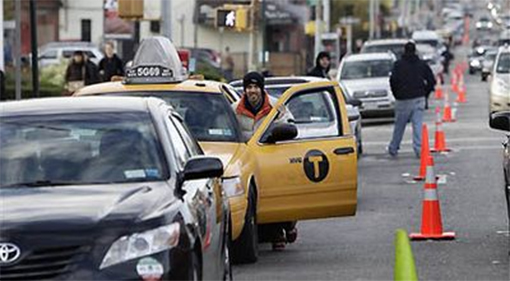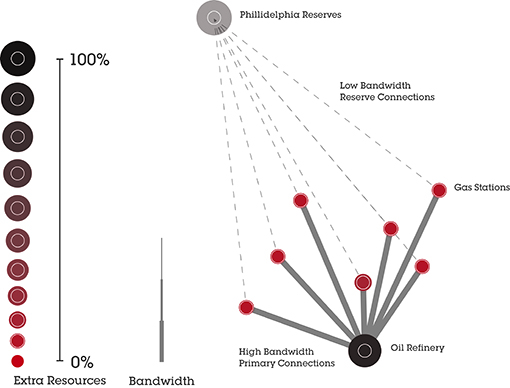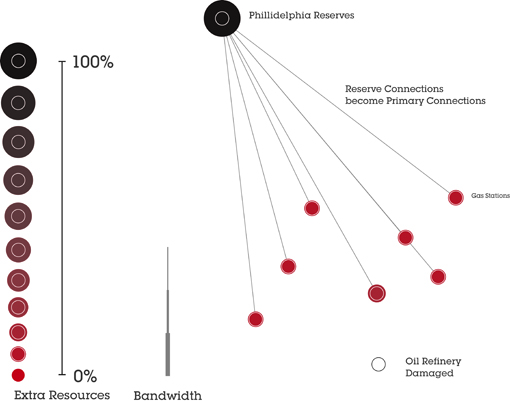Resilience Vs. Efficiency
Posted on December 14, 2012 | posted by:A network is simply a set of interconnecting nodes; exchanges are made through connections between the nodes and these two elements form a larger system. There are computer networks like the internet, supply networks like the food supply chain into New York, social networks like your groups of friends, and so on. Networks are often over simplified by only discussing their structure; for example, if you have a decentralised and interconnected network it is naturally resilient. The structure is; of course, an important factor; however, there are at least two other factors to be considered; resources and bandwidth.
Resources are the reason a network exists whether the resource is digital traffic, vegetables or friendship; networks are required to transport them. Bandwidth is the networks ability to move these resources around. If the connections have a poor bandwidth, like a too narrow highway, traffic starts backing up and resources move slowly.
A strong network necessitates good resource flow so every node gets the resources it requires. Networks also need to be efficient so resources are not wasted and resilient so that in times of crisis they can be rebuilt. Structure affects all these factors, but so too do bandwidth and resources and when taken into account, a perverse relationship develops between network resilience and network efficiency: A network can never be both efficient and resilient.
Resilience is the extent to which a network can survive a moment of crisis. Survival requires all nodes in a network to have adequate access to essential resources, even in times of crisis. To ensure the system has enough resources for a range of eventualities, stockpiles of resources need to be amassed; resilience requires excess. These stocks can be relatively small for the day-to-day fluctuations in resource flow; but, more rare emergency situations require contingency plans. Emergency plans usually involve drawing on external resources, these resources depend on building connections just in time and a suppliers ability to supply them exactly when they are required. This is risky, if the supplier is low on resources they may refuse access to them or if connections cannot be made quickly or are low bandwidth then resources might not be received fast enough. The alternative is to build up stocks of spare resources within your own network; this is expensive. Idle resources are wasted resources, especially as most resources degrade with time and cannot be stored indefinitely.
The recent gas crisis here in New York, after hurricane Sandy, is a good example of a network breaking down. The oil refinery in New Jersey was damaged by salt water; this is the equivalent of a resource-creating node being removed from the network. The gas stations are the other nodes in this network and between them they had some gas in storage, this is the excess resource; unfortunately New York has lots of cars. This is not a resilient network; there was one centralised node, which provided all the resources to the other nodes. When it was removed, the network had to rely on its reserves, which quickly ran out. The emergency connections in place had too small a bandwidth to be of any use. Trucks filled up with gas in Philadelphia and drove to New York, allowing for emergency vehicles and essential traffic to keep moving but the rest of New York’s traffic came to a stop.
The network diagram below shows more than just connections and structure, it also defines bandwidth, emergency connections and resource load. Clearly New York’s gas network is not resilient, it is a centralised network with all its resources stored and created in one location, and it was this node that was removed. Reliable contingencies had been put into place but their bandwidth was too narrow. Some spare resources were stockpiled but not enough to cover the network for the required amount of time to repair the lost node. As a result New York’s gas network failed.
What could be done to build a more resilient network? It, of course, would be better to build three individual refineries in three different locations, operated independently. This way if one is removed a third less damage is done to the network. So why wasn’t this done? The answer; efficiency.
By centralising and scaling up efficiency is increased; only one control room is needed per refinery, no matter how big it is. Three plants separate plants require three separate control rooms. These control rooms would need to be staffed and individually fitted out with a range of equipment. All of these are costly resources that would have to be purchased and maintained. As can be seen, when looked at from a resource perspective it makes much more sense to centralise the refinery.
To get resilience you have to sacrifice efficiency. To build efficiency you have to sacrifice resilience. Restaurants and supermarkets over order food stocks to ensure resilience and waste vast amounts of produce, New York builds an efficient gas distribution system, to save money, and runs out of gas when the system is stressed. When building new systems, a designer must, through correct distribution of resources, emergency connections and allocation of bandwidth, attempt to balance the universal and intractable tension between resilience and efficiency.



